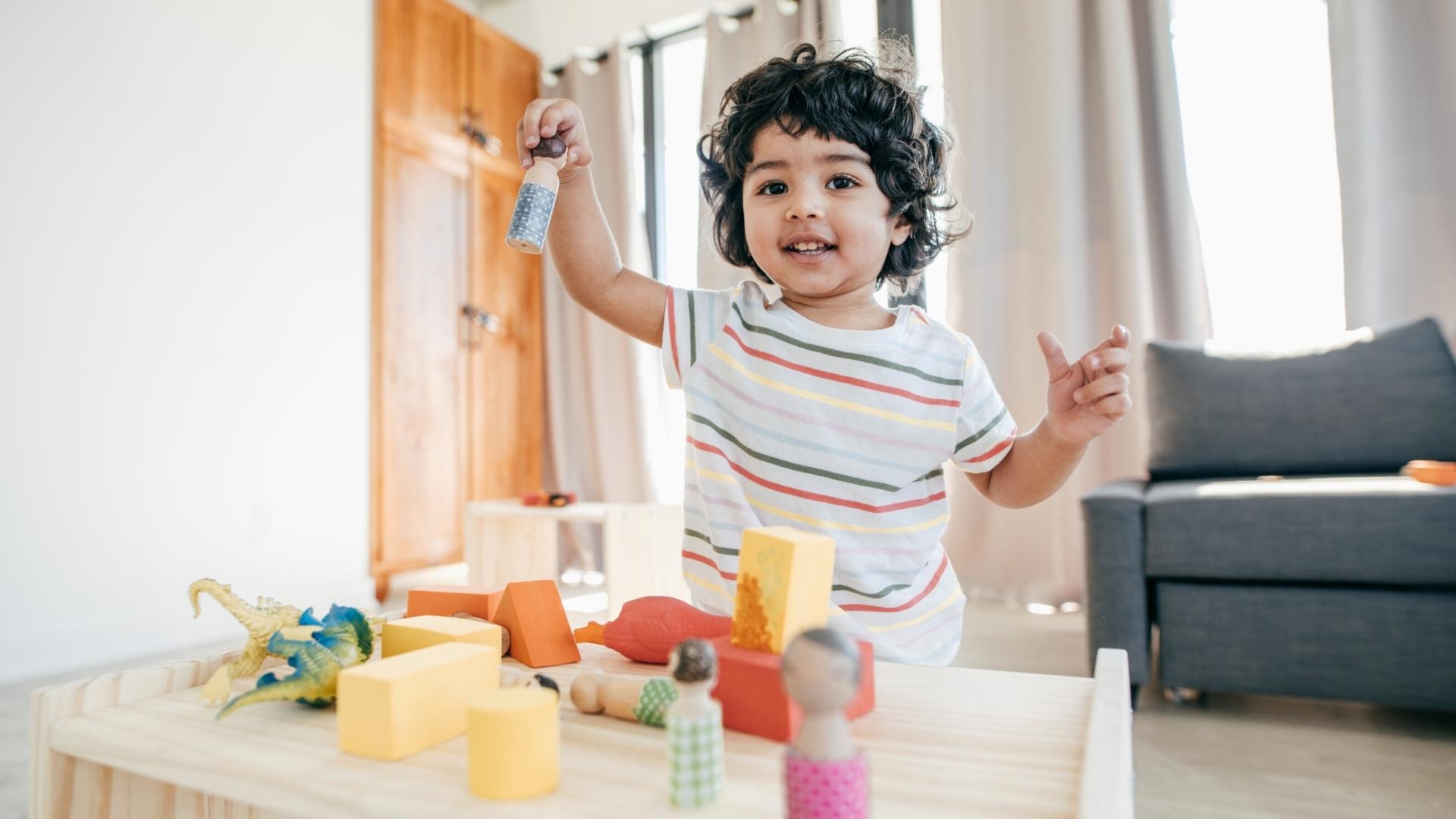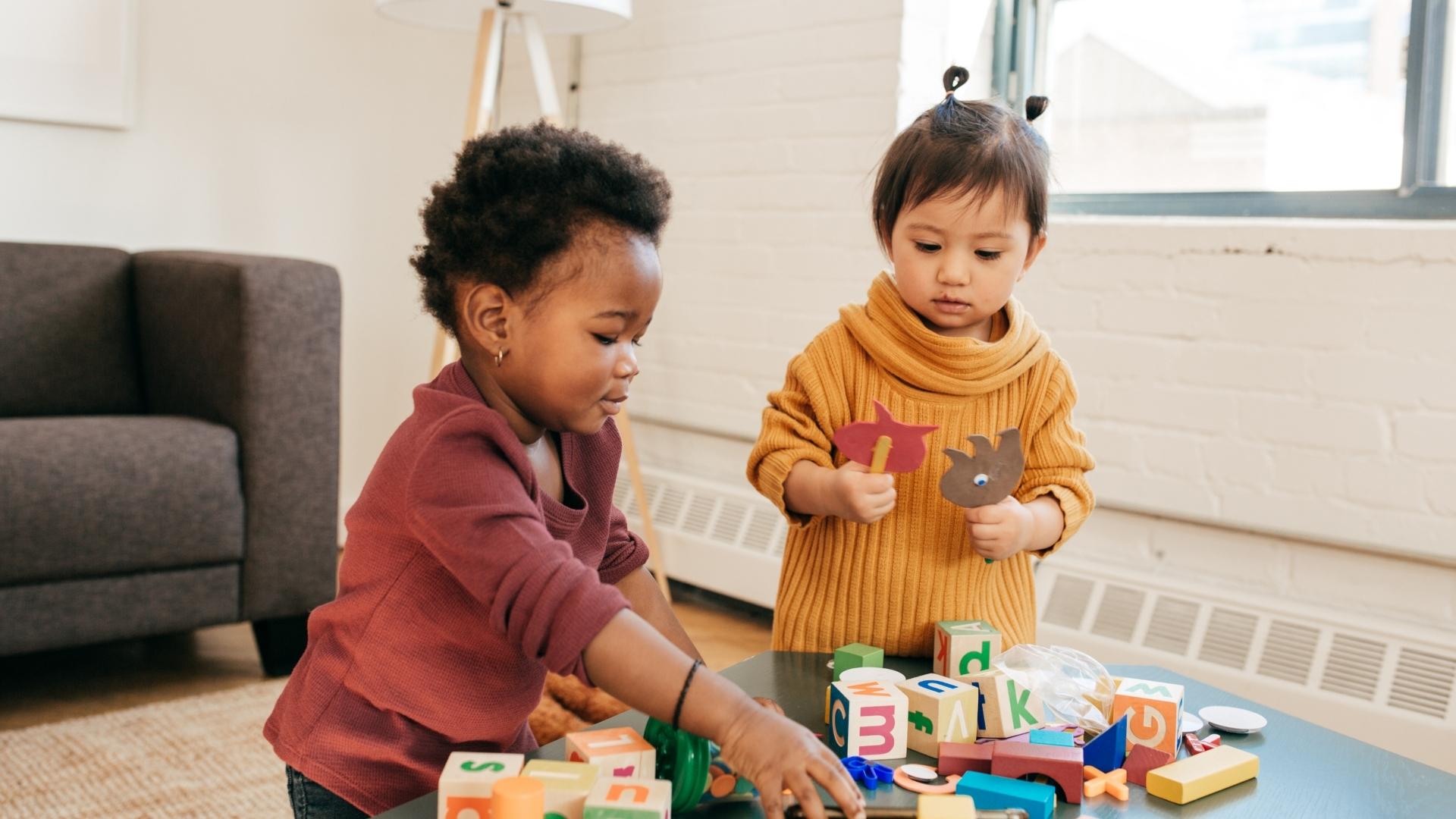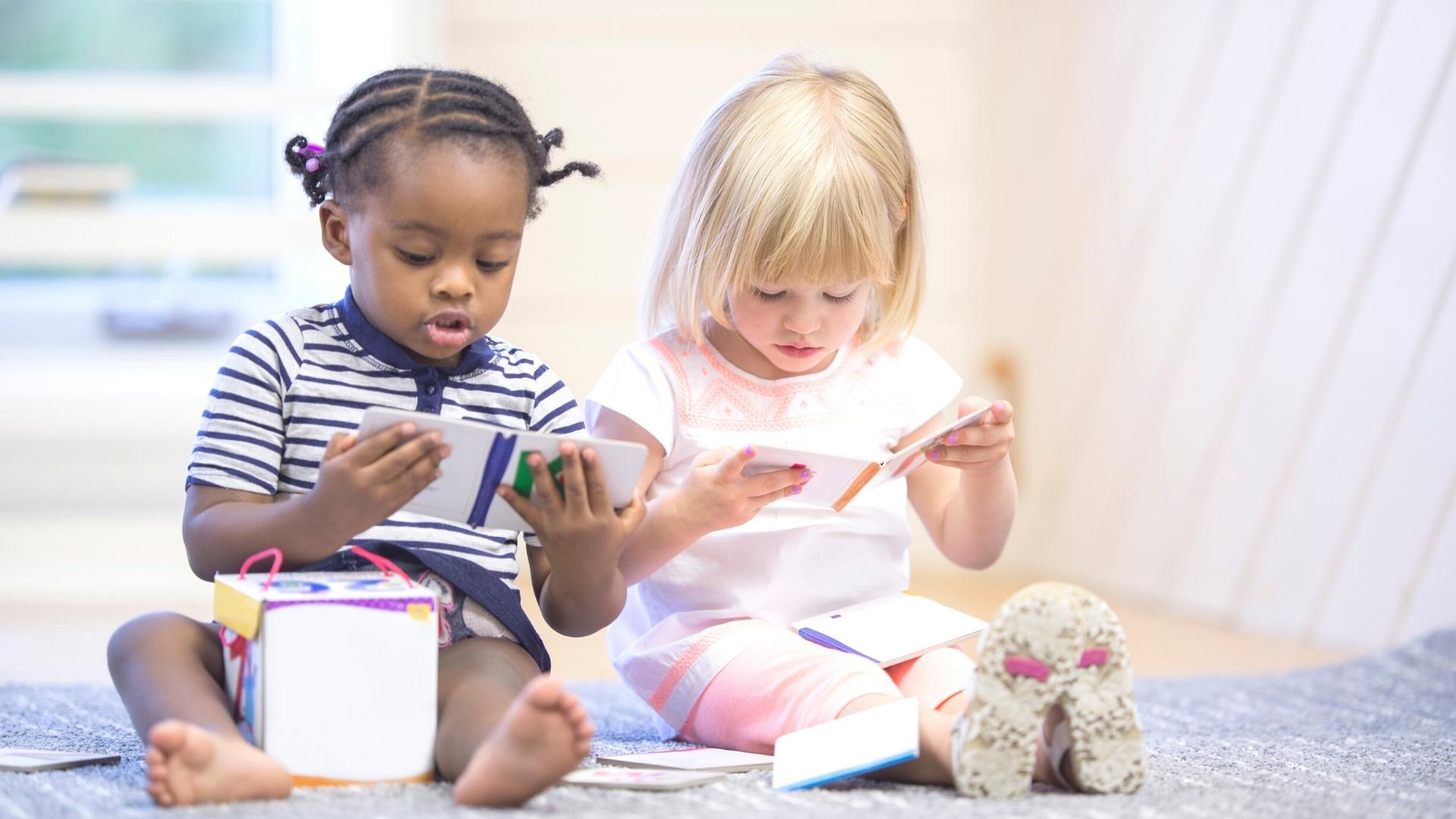We all know it’s important for kids to play… But did you know that it’s equally as important to let your child’s imagination take the lead? That’s where self-directed play comes in.
Here’s all you need to know about child-led play sessions and why you need to include them in your daily routine.

Table of Contents
What Is Self-Directed Play?
Self-directed play is the type of play where children choose what to play and make up their own rules for how to play. During self-directed play, children are in charge of their own lives, and they have the freedom to explore their own interests, ideas, and instincts.
What Age Can Children Do Self-Directed Play?
The truth is… children of all ages can participate in self-directed play.
Even infants will engage in exploratory play, such as shaking a rattle or grabbing a toy.
As children grow, their play becomes more complex and imaginative, allowing them to explore the world around them and develop their cognitive and social skills.
However, it’s important to note that the type of self-directed play will vary based on the child’s age and developmental stage.
Infants and toddlers may engage in more sensory play, such as exploring different textures and shapes, while older children may engage in imaginative play, such as pretending to be a superhero or playing house.
Examples of Self-directed Play
Here are some fun activities and specific examples of child-led play for outdoor, indoor, and at-home play.
Self-Directed Outdoor Play
When children are outside, they have more space to explore and can use their imaginations to create their own games. Some examples of self-directed outdoor play include:
- Building a fort or treehouse
- Exploring nature, such as looking for bugs or identifying different types of plants
- Playing with water, such as in a sprinkler or a small pool
- Riding bikes or scooters and creating obstacle courses
- Playing games like tag or hide-and-seek
- Making mudpies
- Having an outdoor tea party
Self-Directed Indoor Play
Indoor play can also be a great opportunity for self-directed play, especially during bad weather or in smaller living spaces. Here are some examples of self-directed indoor play:
- Building with blocks or Legos
- Creating art with various materials like paint, markers, or clay
- Playing dress-up or make-believe games
- Engaging in sensory play, like playing with slime or kinetic sand
- Playing board games or card games with friends or family
- Making an indoor fort with sheets and furniture
Self-Directed Play At Home
Child-directed play can also happen at home, without any specific toys or equipment. Here are some examples of self-directed play that can be done at home:
- Reading books and creating stories in your imagination
- Playing with household items like pots and pans, cardboard boxes, or blankets
- Creating a scavenger hunt or treasure hunt
- Engaging in imaginative play, like pretending to be a superhero or a chef
- Playing with pets or stuffed animals
- Playing with puzzles
- Playing with wooden train sets, farm yards, or towns
- Even giving your child a cardboard tube can have endless play opportunities!
REMEMBER: Self-directed play is an important part of your little one’s development and can lead to increased creativity, problem-solving skills, and independence. By providing plenty of opportunities for self-directed play, you can help your child develop important life skills while at the same time having lots of fun.
Self-Directed Play for Babies
As I mentioned earlier, even babies can engage in self-directed play. And whilst it’s wise to offer age-appropriate activities, the point of child-led learning is to let your little one explore what they can do!
So to allow your baby to engage in solitary play, provide a safe environment and a few of these baby’s self-directed play opportunities:
- Cloth books with different textures
- Play gyms
- Foot and wrist rattles
- Tummy time mats
- Creating sensory bins (a tray filled with items of different textures, sounds and colors)
This play gym is designed by experts for baby's developing brain and body. Winner of multiple awards it includes everything you need in an activity gym-from batting to teething to learning to focus-for a whole year of play.
Bonus Open Ended Play Ideas
One Hundred Toys have written a great article to provide you with a list of brilliant ideas for open-ended play toys that are perfect for offering child-directed play opportunities.
You can discover that list here.
Here’s also a video from Champions for Early Education to help you visualize these amazing playtime ideas.
Principles of Self-Directed Play
Self-directed play is a type of play where children create their own fun and games and usually make up their own rules for how to play.
In my opinion, self-directed play is one of the highest forms of education for your child as it is crucial for the exploration of their world and understanding of their preferences and interests.
Especially as children are in control of their own learning through internal motivation and are free to explore their environment in a way that is meaningful to them.
1. Self-Directed Play Is Child-Initiated Play
This means your child decides what to play and how to play it.
In other words, you provide a safe and supportive environment for your little one to explore and learn… and you can provide materials or suggestions for play…
But ultimately it is up to your child to decide how to use them. Try to resist the adult interference to direct or suggest what they should do!
2. Self-Directed Play Is Open-Ended
This means that there are no specific goals or outcomes that the child is expected to achieve.
Instead, the focus is on the process of play and the learning that occurs through exploration and experimentation.
Open-ended play has all sorts of benefits as it also allows children to develop their creativity, problem-solving skills, and imagination.
3. Self-Directed Play Also Allows For A High Degree Of Autonomy
Child-led play means children are free to make their own choices and decisions about what to play and how to play it.
This helps to build their confidence and sense of independence, all of which are vital to strong mental health habits as your child grows up.
It also allows them to learn from their mistakes and to take risks in a safe and supportive environment.
By allowing children to take control of their own learning and to explore their environment in a way that is meaningful to them, we can help foster their natural curiosity and love of learning.
Looking to get your little one to sleep quickly and effortlessly? Check out my Bedtime and Nap Cheat Sheet and master the art of making daytime naps and bedtimes as seamless as possible.
A bedtime & nap cheat sheet so good your little one will ask you to put them to bed...
Laura Williams "This is a life saver! I'm so glad I downloaded your bedtime & nap cheat sheet. My little one actually asked me to put him to bed last night! Unbelievable! Thank you so much!"
Click Here For The FREE Cheat Sheet
Benefits Of Self Directed Play
Self directed play has many positive effects in terms of how it helps with cognitive development, enhancing social skills, and encouraging emotional growth.
1. Cognitive Development. Self-directed play has been shown to help in the development of young children’s cognitive skills.
When children engage in self-directed play, they are using their imagination, creativity, problem-solving, and decision-making skills which are essential for their cognitive development and will help them succeed later on in school and in life.
2. Social Skills Enhancement. This type of play also enhances children’s social skills. When children engage in self-directed play, they naturally learn how to communicate, negotiate, and cooperate with others. They also learn how to share, take turns, and resolve conflicts.
These social skills are essential for their social development and will help them build positive relationships with others.
3. Emotional Growth. Child-directed play can also contribute to your little one’s emotional growth. This type of play allows children to express themselves by exploring their emotions, and learning how to regulate them. They will also learn how to cope with stress and anxiety in a safe place when things don’t go to plan.
These skills are essential for their healthy emotional development and will help them become more resilient and emotionally intelligent as they grow.
Challenges Of Setting Up Self-Directed Play
Some parents may struggle to stand back when their child is engaging in self-directed play.
However, for your little one to get the most out of this important aspect of their early learning through play you must be willing to hand over some control and let your child take the reins.
This may not be easy at first, so here are my tips for overcoming the most common challenges that come with self-directed play.
1. Overcoming Parental Anxiety. As a parent, it can be difficult to let your child engage in self-directed play without feeling anxious or worried about their safety. However, it is important to remember that self-directed play is a crucial aspect of your child’s development.
To overcome this anxiety, consider setting clear boundaries and guidelines for your child’s play, and gradually increasing their independence as they demonstrate their ability to make safe choices.
2. Facilitating Not Directing. One of the biggest challenges in self-directed play is finding the balance between facilitating your child’s play and directing it. It is important to remember that self-directed play is about allowing your child to explore and create on their own terms, so instead of directing their play, try providing open-ended materials and asking open-ended questions to encourage their creativity and imagination.
3. Creating A Safe Environment. Creating a safe environment for child-directed play is crucial to ensure your child’s physical and emotional well-being. This results in you not having to step in for fear of them hurting themselves.
Ways to do this are to provide age-appropriate toys and materials, ensure that the play area is free from hazards, and supervise your child’s play from a distance to ensure their safety.
4. Managing Risk. While it is important to create a safe environment for your child’s self-directed play, it is also important to allow for some level of risk-taking. This will help your child develop important skills such as problem-solving, decision-making, and resilience.
To manage risk and help reduce your worry about them coming to harm, set clear boundaries and guidelines, and gradually allow your child more freedom as they demonstrate their ability to make safe choices.
Self-Directed Play and Technology
In today’s digital age, it can be all too easy to default to technology for self-directed play.
While technology can be a valuable tool for learning and creativity, I do not believe that very young children need technology and that other types of self-directed play are far more beneficial.
Self-directed play for this age group should involve physical activity, social interaction, and imaginative play.
If you do opt for technology… consider setting limits on screen time and encouraging your child to engage in a variety of play activities both on and off-screen.
Frequently Asked Questions About Self-Directed Play
Looking for more information about self-directed play? Here are the answers to the most common questions.
How Can Adults Support And Encourage Self-Directed Play?
Adults can support and encourage self-directed play by providing a variety of open-ended materials and toys, allowing children to choose their own activities, and giving them the time and space to explore and experiment. It is important for adults to resist the urge to direct or control children’s play experiences.
What Is The Difference Between Self-Directed Play And Directed Play In Early Childhood?
Directed play is when adults provide specific instructions or activities for children to follow, while self-directed play is when children are able to choose their own activities and guide their own play experiences. Both types of play can be beneficial for children, but self-directed play allows for more creativity and independence.
How Can Self-Directed Play Be Used In Speech Therapy For Children?
Self-directed play can be used in speech therapy for children by providing opportunities for them to practice communication skills in a natural and enjoyable setting. For example, playing with dolls or action figures can provide opportunities for children to practice conversation skills and storytelling.
Comparing Self Directed Play And Structured Play
Structured play is when adults provide specific rules and goals for children to follow, while self-directed play allows children to choose their own activities and guide their own play experiences. Both types of play can be beneficial for children, but self-directed play allows for more creativity and independence.
What Is The Role Of Intrinsically Motivated Play In Child Development?
Intrinsically motivated play is play that is driven by a child’s own interests and desires, rather than external rewards or pressures. This type of play is important for child development because it allows children to explore their own interests and develop their own sense of motivation and self-direction. It also promotes creativity, problem-solving, and critical thinking skills.
Need More Parenting Help?
- Download our FREE Bedtime & Nap Sleep Cheat Sheet. It’s a free, easy-to-use and proven formula designed for parents of 0-5 year olds to master the art of consistently undisturbed and restful sleep without the yelling, nagging or exhausting long-winded evenings.
- Check out our Parenting Toolbox. You’ll get access to expertly-chosen products that you can guarantee are the best for your little one and your wallet.
- Are you looking for personalized guidance to navigate the challenges of parenting? I offer 1-on-1 consultations to bring you tailored strategies and actionable advice to help support your child's growth and well-being with confidence.

A bedtime & nap cheat sheet so good your little one will ask you to put them to bed...
Laura Williams "This is a life saver! I'm so glad I downloaded your bedtime & nap cheat sheet. My little one actually asked me to put him to bed last night! Unbelievable! Thank you so much!"
Click Here For The FREE Cheat Sheet



